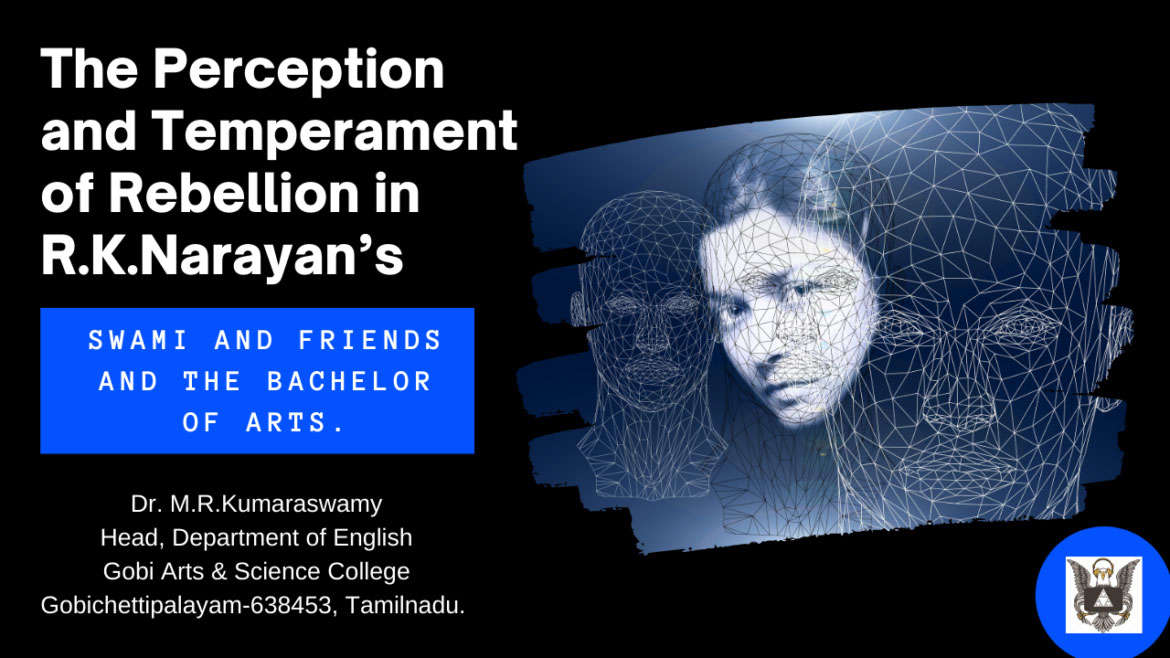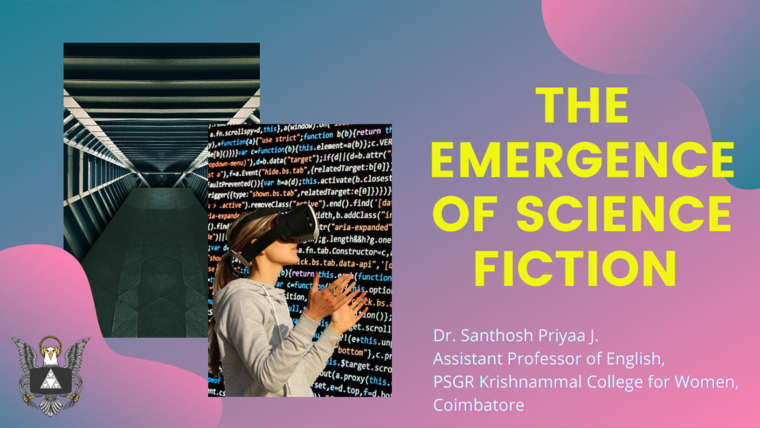Dr. M.R.Kumaraswamy
Head, Department of English
Gobi Arts & Science College
Gobichettipalayam-638453
Email: emmarkumar@gmail.com
Mobile: +91 9786342828
Abstract
Rebellion means “open or determined defense of, or resistance to any controlling power”. It is part and parcel of human consciousness. Rebellion as such in Narayan’s novels maybe considered as a deviation rather than as a defiance. In Swami and Friends there are several instances where Swami is portrayed as a rebel and his rebellion in its entirety is taken as a deviation from the accepted norms. To understand the nature of Swami’s rebellion we have to telescope the rebellious influences on him. In The Bachelor of Arts, the motif of rebellion follows the pattern employed in Swami and Friends. Illustrations from the text go to show how the character Chandran is shown as a rebel owing to situations that occur in the course of his life.
Introduction
According to the Oxford English Dictionary rebellion means “Open or determined defense of, or resistance to, any authority or controlling power.” Albert Camus in his book The Rebel views rebellion thus:
The problem of rebellion only seems to assume a precise meaning within the confines of the Western thought … In fact for the Inca and the Hindu pariah the problem of revolt never arises, because it has been solved by tradition before they had time to raise it – the answer being that tradition is sacrosanct. (25-26)
These definitions of rebellion serve as the backdrop and the pointers throughout the typology of rebellion. Rebellion as such is a part and parcel of human consciousness. As a natural human tendency, it seems to have its roots in the stout of “Man’s first Disobedience.” Satan, in the guise of the talking serpent has instilled the essence of rebellion into Eve’s consciousness. Apart from the Biblical roots, the idea behind the forbidden fruit has a universal appeal. It underlines the instinct to break the code and disobey the commandment.
The typological term rebellion may indeed appear paradoxical and irrelevant in the context of Narayan’s novels. Narayan’s characters are placed in a pre-ordained conceived world. They have an acute Karma-consciousness and imbibe the pervading spirit of the cultural tradition. Theirs is essentially a sacrosanct tradition. Rebellion against the accepted norms of their tradition appears meaningless. Camus’s view is that the Indians cannot rebel because they have their answers ready in their myths. In other words, in the tradition of Acceptance, rebellion may be interpreted as a cultural aberration. In fact, rebellion as such in the world of Narayan’s novels is regarded more of a deviation than defiance. Hence Narayan’s presentment of his typical rebels may be considered as an interesting study of rebellion suggesting socio-psycho-cultural implications.
Perception and Temperament of Rebellion in Swami and Friends
Swami in Swami and Friends, though stands obviously as a clear illustration of innocence, he is also viewed as the eternal rebel. He is Narayan’s first potential rebel. His dual perception of rebellion is: rebellion as Swami’s natural and instinctive trait and rebellion, in its symbolic connotation, born out of Swami’s illusive understanding of life. Although Swami displays certain revolting or defying tendencies, his rebellion in its entirety is taken as a deviation from the accepted norms.
Narayan’s first protagonist, Swami presents himself as a typical rebel. Swami, the ordinary and average school boy with his instinct to play the rebel, finds himself inadequately equipped. He has no potential ability to translate it into action. His potential urge is paralyzed, every time, by his dominant cowardice in the face of challenge. It is the middle-class psychology of the boy that nullifies his desire to reach the fruit. He cannot snap the ropes of the codes. Ultimately, even the innocent Swami has his day as he finds himself playing the biggest rebel of his life. But rebellion at what cost? This seems to be a million dollar question in Narayan’s Malgudi. It is here that several implications emerge out of Swami’s rebellion. The typology intends to consider them in the context of Narayan’s novels.
To understand the nature of Swami’s rebellion is, perhaps, to telescope the rebellious influences on him. Mani, the young hero’s alter-ego moves like his shadow and remains one lasting influence on Swami. Swaminathan cannot remain unaffected in the company of Mani who seems to be epitomizing and exuding rebellious tendencies. As a matter of fact the sensitive and impressionistic Swami comes to hero-worship Mani and keeps feeding his own fancy on the latter’s heroic deeds.
Besides Mani’s influence, Swami’s rebellion impulses get fanned as Rajam appears on the scene. Rajam proves to be the most dominating and snobbish influence on
the plebeian Swami. He lands as the tempestual whirlwind in the quiet life of Swami’s cowardice. Thus, Mani and Rajam contribute to the rebellious nature of Swami. Swami is found in the company of the patriotic crowd on the day of the Hartal. Carried away by the mob psychology, he refuses to enter into the school, despite the Head Master’s repeated appeals to get back to the classes. Instead, he executes his first real defiance thus:
He uttered a sharp cry of joy as he discovered a whole ventilator, consisting of small square glasses in the Head Master’s room, intact! He sent up a stone at in and waited with cocked up ears for the splintering noise, as the piece crashed on the floor. It was thrilling. (28)
The second act of Swami’s rebellion in fact follows as the consequence of the first. As the Head Master, determined to teach Swami a lesson for his devilry gives him six whacks of the cane and orders him to stand on the desk, he acts fast. “He jumped down, and grasping his books, rushed out muttering, ‘I don’t care for your dirty school.’” (106) His third and final act, however, becomes more pronounced. Standing fully exposed to the Head Master of the Board School for bunking drill practice, Swami, sensing the imminent punishment, gets alerted: “He hardly knew what he was doing. His arm shot out, plucked the cane from the Head Master’s hand, and flung it out of the window.” (144)
As Swami lands in the no man’s land, the Mempi Forest, as he undergoes the painful journey and finally is brought back home, almost from the death-trap, providentially perhaps, Narayan seems to have added a dimension to the popularly understood notion of rebellion. Swami’s defiance is different and even unique is his conception of his forest escapade. His journey becomes the writer’s strategy, known as rite de passage. The rite de passage offers a new perspective to Swami’s rebellion.
The young hero’s rebellion may be regarded as the novelist’s strategy to project the world of Swami’s illusions. Swami seems to have been misled, thanks mainly to his inflated ego nourished by the tempting influences of Mani and Rajam, making him blind to the reality of his self and consequently living in the world of illusion. But the trip to the Mempi Forest seems to have made the erring and the wayward boy to realize the reality about himself and finally brought him back to the proper and desirably normal state of mind. It is in this sense that the rite de passage marks Swami’s development too. Putting it differently, although Swami appears flat, he seems to have made a subtle development by realizing the folly of taking illusion for reality. His growth may be viewed in his return to the ordinary and essentially normal state of existence.
The rebellion in Swami and Friends may be viewed as Narayan’s strategy to underline the theme of illusion versus reality. His concept of rebellion, therefore, may be taken as the protagonist’s deviation from the accepted reality to the undesirable word of illusion. The treatment of rebellion is realized through the cyclic pattern of the hero’s development. It also suggests the theme of the return of the native and stresses the influence of the tradition as the protecting and sheltering spirit.
Perception and Temperament of Rebellion in The Bachelor of Arts
Narayan’s second novel, The Bachelor of Arts, constitutes the second part of his autobiographical trilogy. As the entire locale of the first novel progressively continues in the second, Swaminathan of the Board School grows as the graduating Chandran of the Albert Mission College in The Bachelor of Arts. As for the motif of rebellion, the novel follows the pattern employed in Swami and Friends. Rebellion in The Bachelor of Arts also seems to be the novelist’s strategy to realize the basic theme of his novels: illusion versus reality. Chandran, although an improved version of Swami as a rebel, in the final analysis, is realized more as a deviant than as a defier.
Chandran comes out as a carefully realized study of rebellion. Before he plays the decisive rebel, Chandran displays a gradual but unmistakable progress as a defier. A mere mention of his suggestive behavioral pattern may underline Chandran as the most rebellion prone youth: The ego-centric myth of Chandran’s oratory is like Swami’s Tate in Swami and Friends; he assumes that he is superior to others; he has a cynical attitude towards Principal Brown, for he is an Englishman; he thinks highly about his bachelor’s degree; he belittles the teachers and lampoons Prof. Gajapathi and poses fearless before Prof. Raghavan; he used to go to late film-shows, enjoyed paan and cigarettes; he is often seen on the banks of Sarayu and staring at girls and he falls in love with a total stranger, Malathi.
It is basically through his romantic love for Malathi that Chandran emerges as a rebel. Chandran’s love at first sight and his open declaration of it remain unheard of in the Malagudi locale, his educated and liberal father notwithstanding. Chandran’s declaration of marrying the absolute stranger sends a shock-wave through his entire household. Obsessed with the girl and having reached the mad degree of love, Chandran is often caught fantasizing:
“Could he not just dash into her household, hide in the passage, steal up to her bed at night, crush her in his arms, and carry her away?” (71)
Chandran’s second rebellion follows as a consequence of the first. As the stars seem to have conspired against him, Chandran gets the NO from the girl’s camp, feels dejected and unable to face the harsh reality, and determines to leave the horrible town. Chandran’s departure to Madras may be regarded as a rebellion because, however natural may be the feeling and psychology of the unrequited love, Chandran, in the first place fails to understand the illusory nature of love and secondly he seems to have denounced the sacrosanct tradition in Malgudi.
Chandran’s final rebellion occurs in Madras. The hostile city was to present Chandran with the most horrifying face of reality. Accidentally, the Malgudi youth runs into the most shocking company of a drunkard, Kailas, who takes the former, of all the persons, to a prostitute:
“This was the first time he had been so close to a man in drink; this was the first time he had stood at the portal of a prostitute’s house. He was thoroughly terrified.”(101)
The nightmarish experience precipitates a crisis of conscience in his case and the already turned desperado decides impulsively to play a sanyasi. Eventually Chandran finds himself at Koopal village and there he plays the last rebel and a sanyasi simultaneously.
The rebel Chandran could not play the holy man for long. Eventually, he realizes the nature of his fake sanyasi. The conscience-smitten man, knowing fully, that the rustics took his appearance for reality, decides to stop the fraud. But ironically enough, the rustics obliged him to stay on. Finally, feeling that he was feeding himself on the poor community’s lifeblood, Chandran determines to cast off the borrowed role. Eventually he throws away the suffocating robes of a sanyasi and returns to the loving and caring fold of Malgudi.
Conclusion
Considering the perception of rebellion in The Bachelor of Arts and Swami and Friends, Narayan seems to employ the strategy of rebellion to deal with the theme of illusion versus reality and to underline the philosophy of acceptance. Narayan presents the illusory aspect of life through Chandran’s romantic love and him playing the sanyasa role. As for the romantic love realized through Chandran’s obsession for Malathi, it may be pointed out that Narayan’s typically conventional notion of man-woman relationship does not entertain the idea of love before marriage. Says the novelist:
We believe that marriages are made in heaven and a bride and a groom meet, not by accident or design, but by the decree of fate, the fitness for a match not be gauged by letting them go through the period of courtship but by the study of their horoscopes; boy and girl meet and love after marriage than before. (122-23)
Chandran’s fake-sanyasa symbolizes the illusory concept of life and it has deeper ironic overtones. In fact the moment the terrified man dons the ochre-coloured clothes, the symbol of a holy man, the other alternative is to commit suicide. Thus he underlines its illusory nature. The sanyasa also becomes illusory because it involves the cheating of the innocent rustics and Chandran’s own deception of his self. By playing a sanyasa he wanted to take “a revenge on society, circumstances, and perhaps, too, on destiny” (108). In its ironic realization Chandran’s sanyasa may be taken as the parody of the serenely and spiritually conceived Hindu concept of renunciation.
In Chandran, Narayan presents a typically conventional rebel. Although he is conceived as a modern youth who has the habit of smoking, his romantic love, beneath the veneer of modernity, the Malgudi lad stands traditional. Chandran’s musings immediately after the most impulsive act of love at first sight reveals his affinity for traditional values. He says:
If she was more than fourteen she must be married … what was the use of thinking of a married girl? It would be very improper. (55)
He also displays the same kind of conventional attitude as he thinks of the name of the strange girl. It may also be noted that to the typically Malgudian and by implication the traditional, the city of Madras appears hostile and his confrontation with Kailas and later with the prostitute sends a shocking current in him and the tradition nourished young feels terrified.
In the novel The Bachelor of Arts, it may be pointed out that, despite the underlying themes like illusion versus reality, convention versus modernity and, perhaps, innocence versus experience, the novel does not have even a shadow of didactic appearance. The novel abounds with the instances underlining such comic atmosphere. The chastened Chandren views his old flame in the context of his new goddess of love:
Sushila, Sushila, Sushila. Her name, music, figure, face and everything about her was divine. Sushila, Sasshila-Malathi. It was a tongue twister; he wondered why people liked that name. (162)
Besides the apparent irony, what possibly seems to have been suggested is the nature of human attitude.
In terms of characterization, Chandran is often regarded as a flat character, who, despite the painful experience in his first love and his equally restless sanyasa-interlude, remains incorrigibly romantic. The novelist uses the strategy of rite de passage, to suggest a subtle realization in him. In fact, Chandran seems to have decided to imbibe the spirit of reason and common sense in life. The narrator puts Chandran’s resolution thus:
“Chandran settled down to a life of quiet and sobriety. He felt that his greatest striving ought to be for a life freed from distracting illusion and hysterics.” (123)
Chandran’s resolution suggests his awareness of the illusory nature of life. In fact the subtly suggested growth in Chandran as reflected in his resolution may be taken as the guiding principle of all the Narayan’s protagonists. The Bachelor of Arts may be read as a sequel to Swami and Friends. It seems to be following the pattern, especially of the theme, structure and mode, employed in the first novel of Narayan.
Primary Sources:
Narayan, R.K. Swami and Friends. Mysore: Indian Thought Publications,1983.
Narayan, R.K. The Bachelor of Arts. Mysore: Indian Thought Publications, 1982.
Secondary Sources:
Alphonso Karkala, J.B. Symbolism in R.K. Narayan’s Novels. Comparative World Literature. Mumbai: Nirmal Sadanand Publishers, 1984.
Bhatnagar, M.K. New Insights into the Novels of R.K.Narayan. New Delhi: Atlantic, 2008.
Dadich, Anil. Narayan’s Style: A Linguistic Perspective. Jaipur: Bohra Prakashan, 1996.
Leod, McA.L. (Ed). R.K. Narayan: Critical Studies. New Delhi: Sterling Publishers, 1994.
Panduranga Rao, V. The Art of R.K.Narayan. The Journal of Commonwealth Literature Vol. 5: 1980.
Ramteke, S.R. R.K.Narayan and His Social Perspective. New Delhi: Atlantic, 1998.



